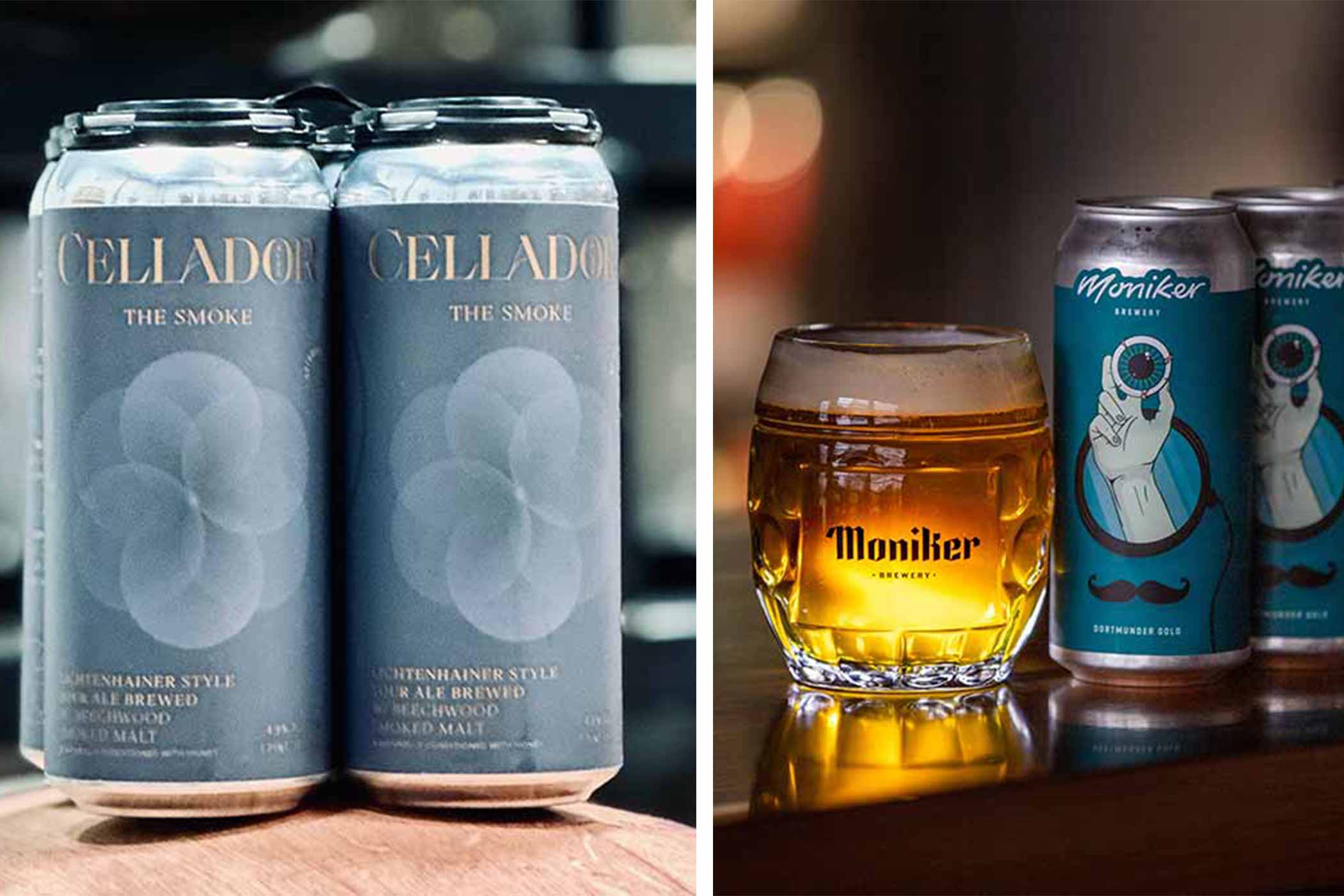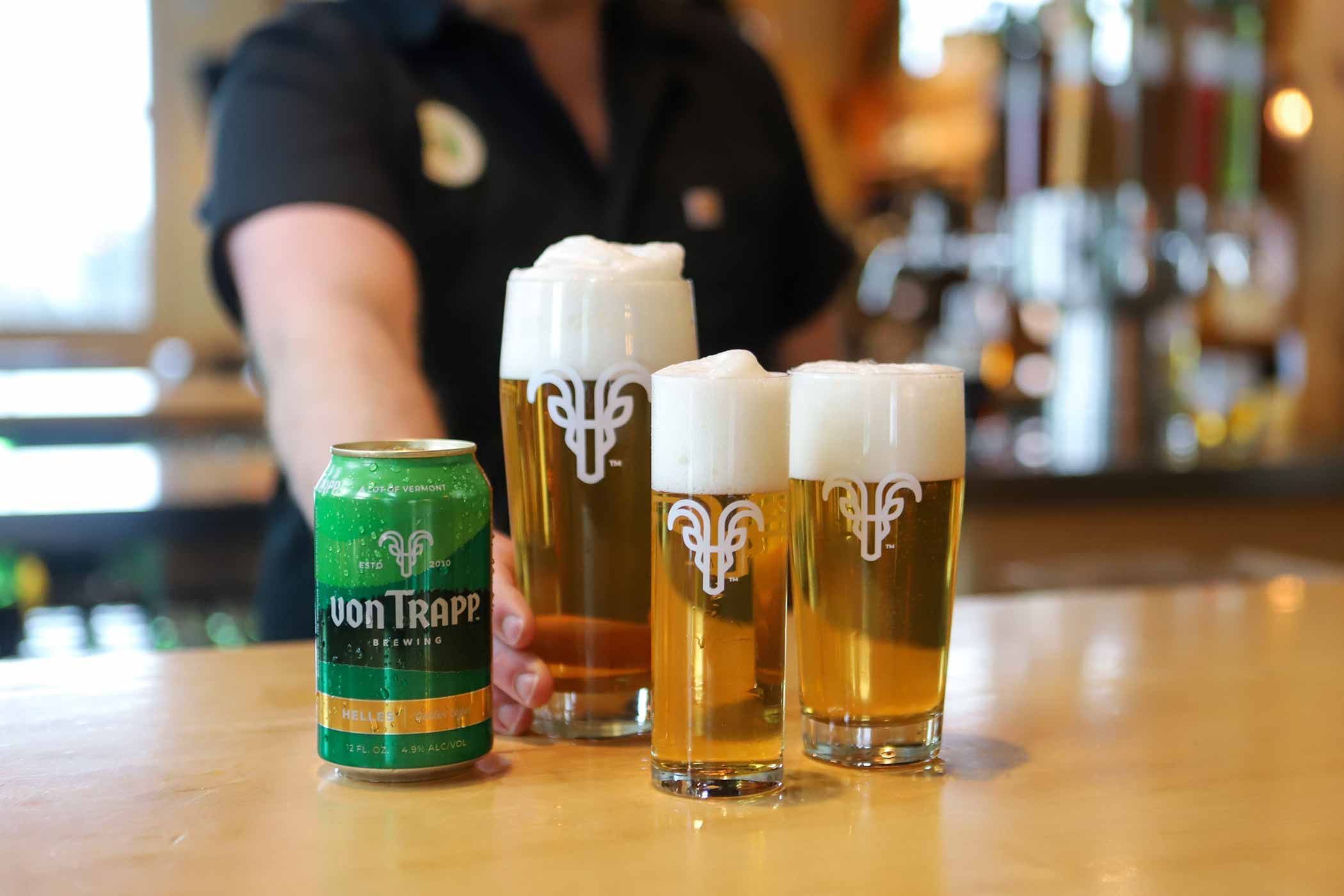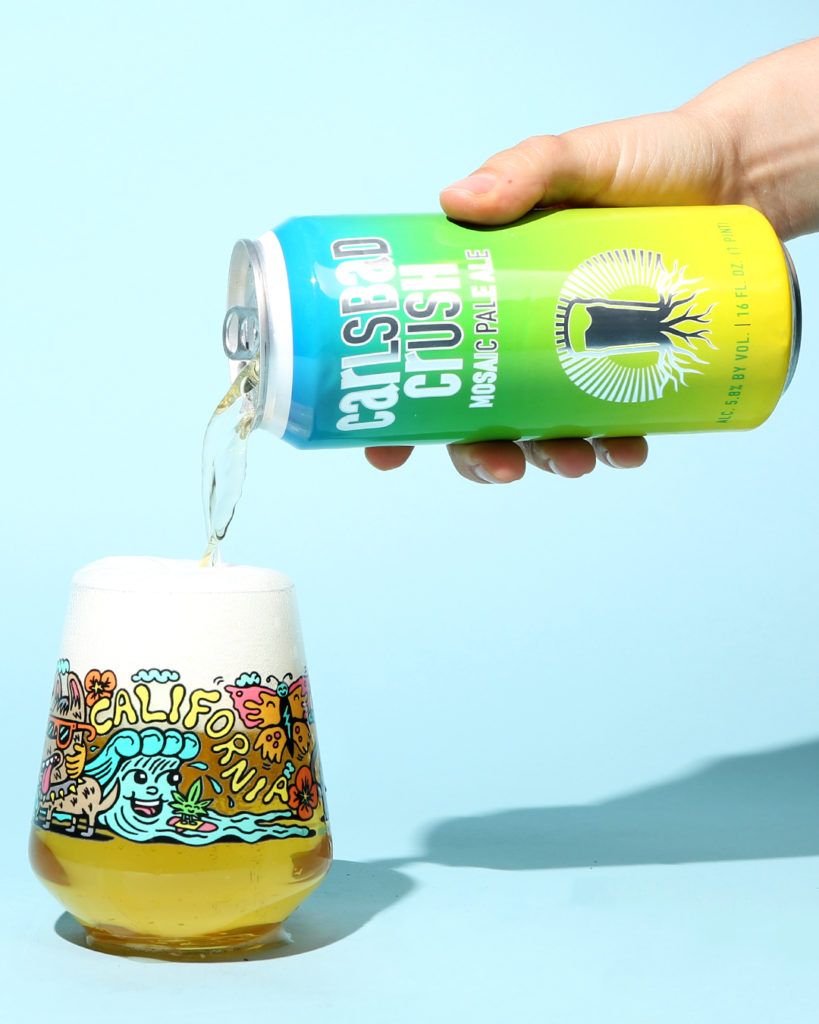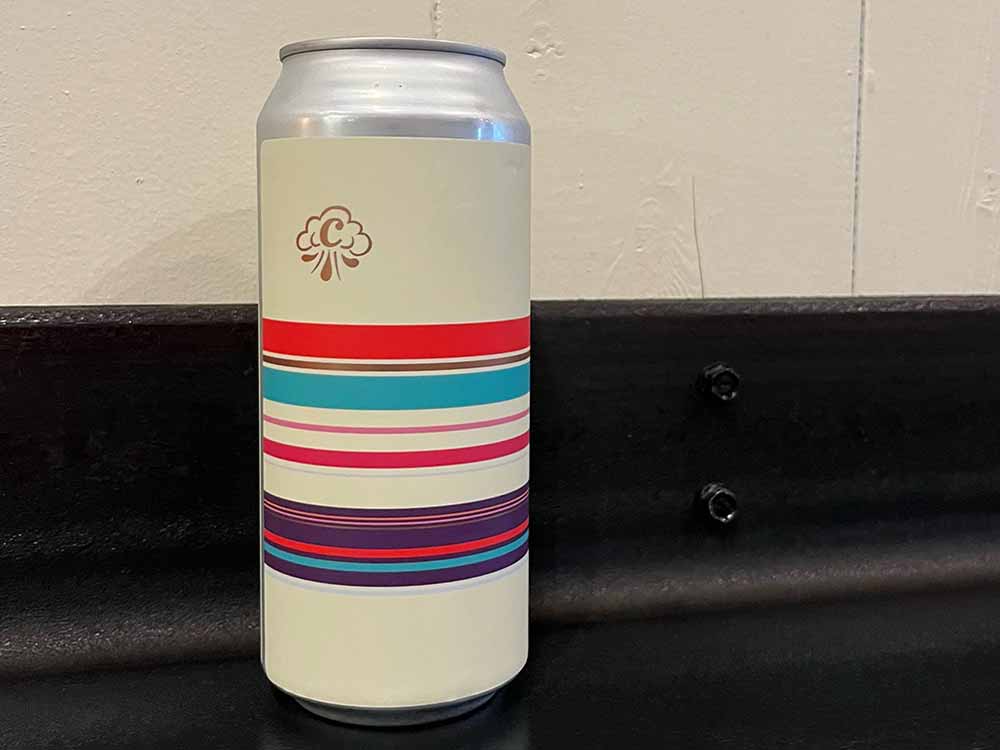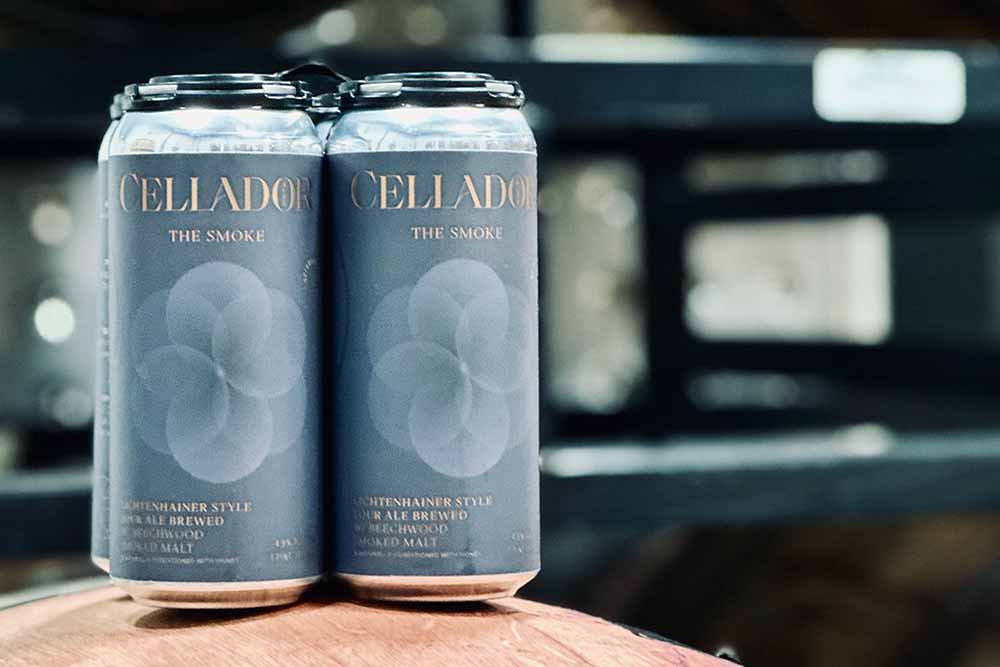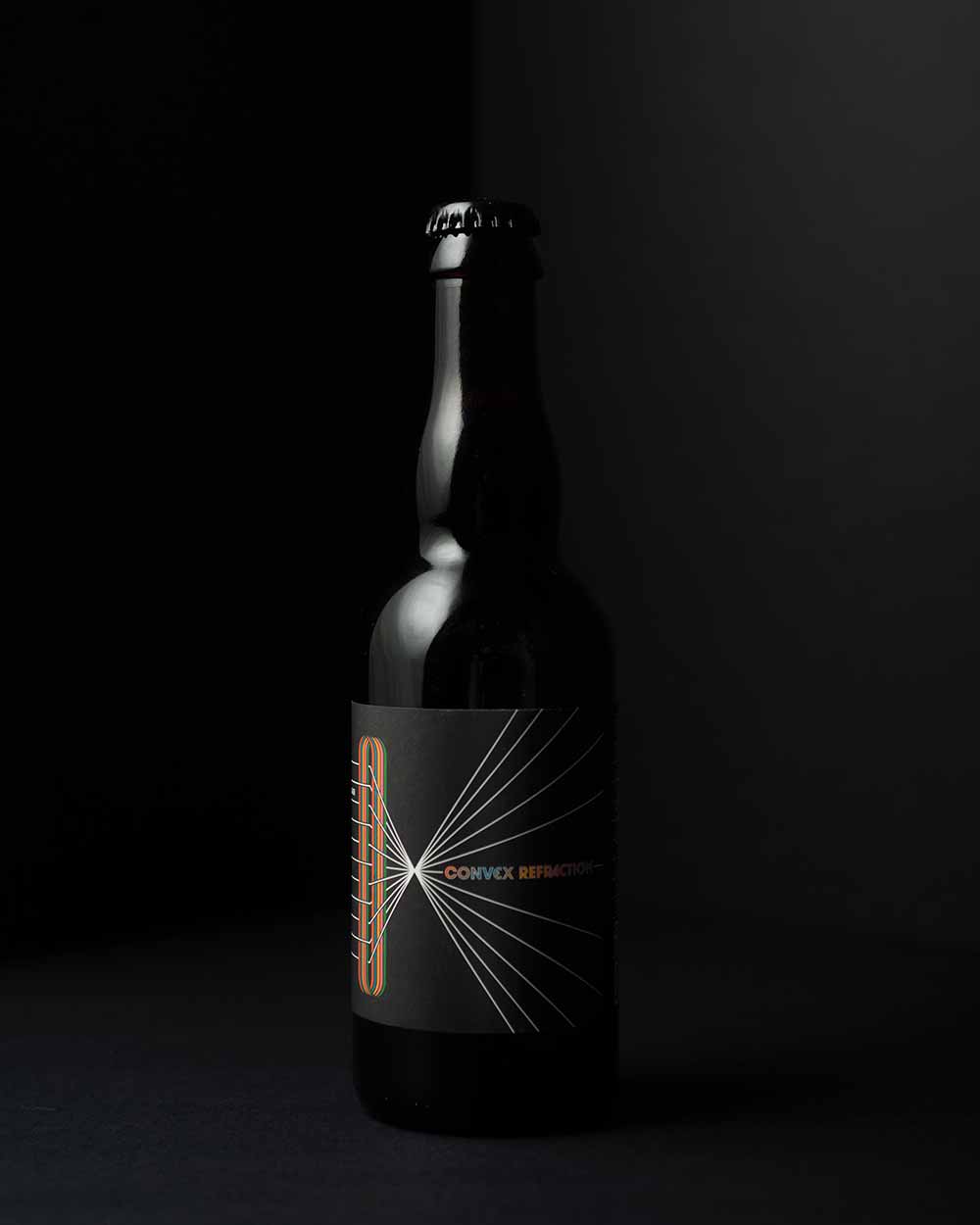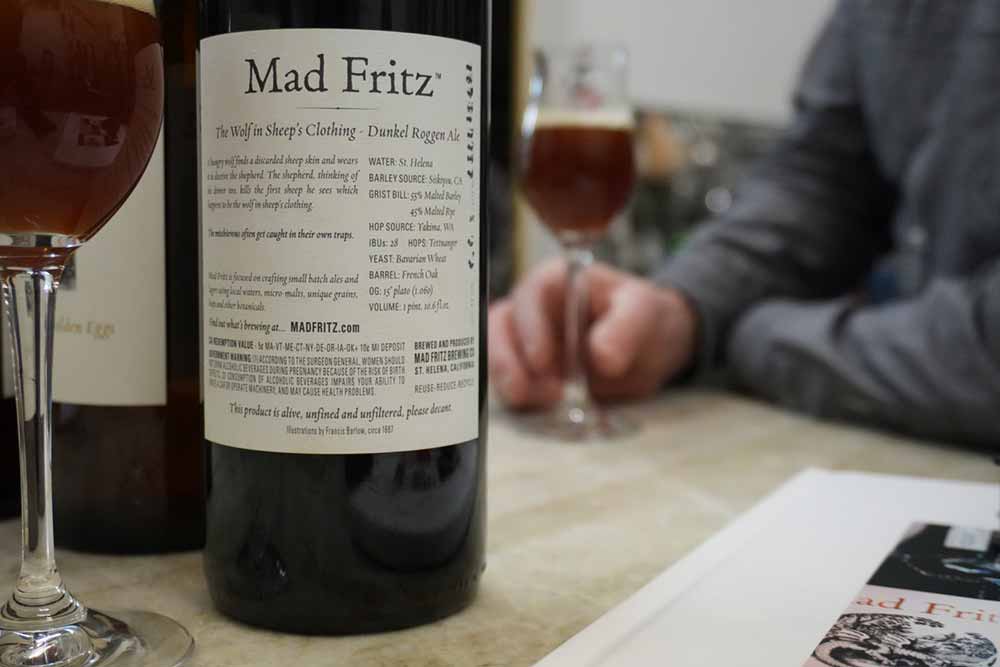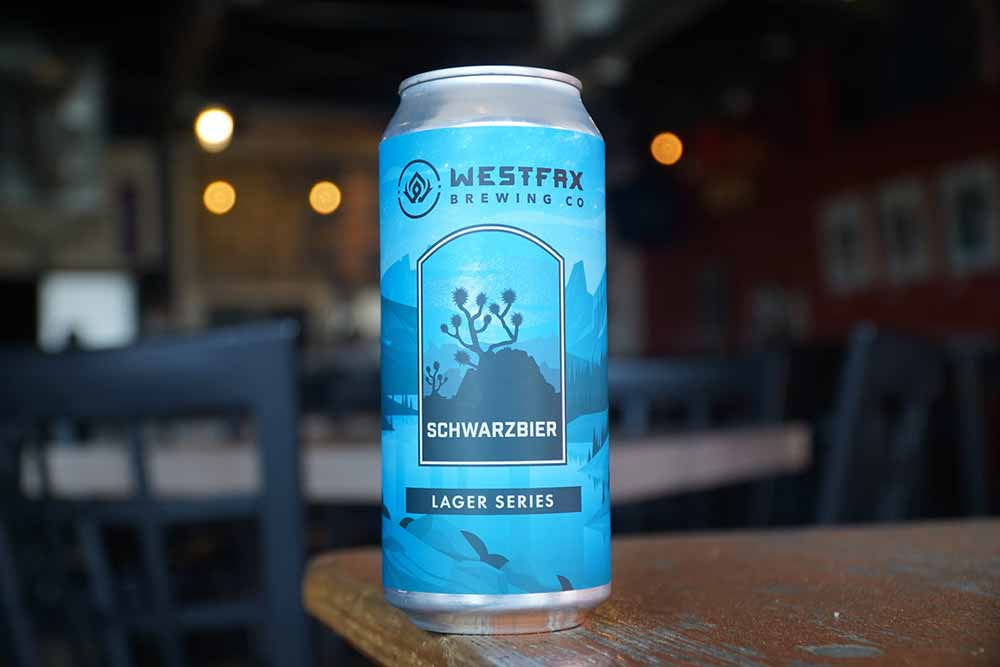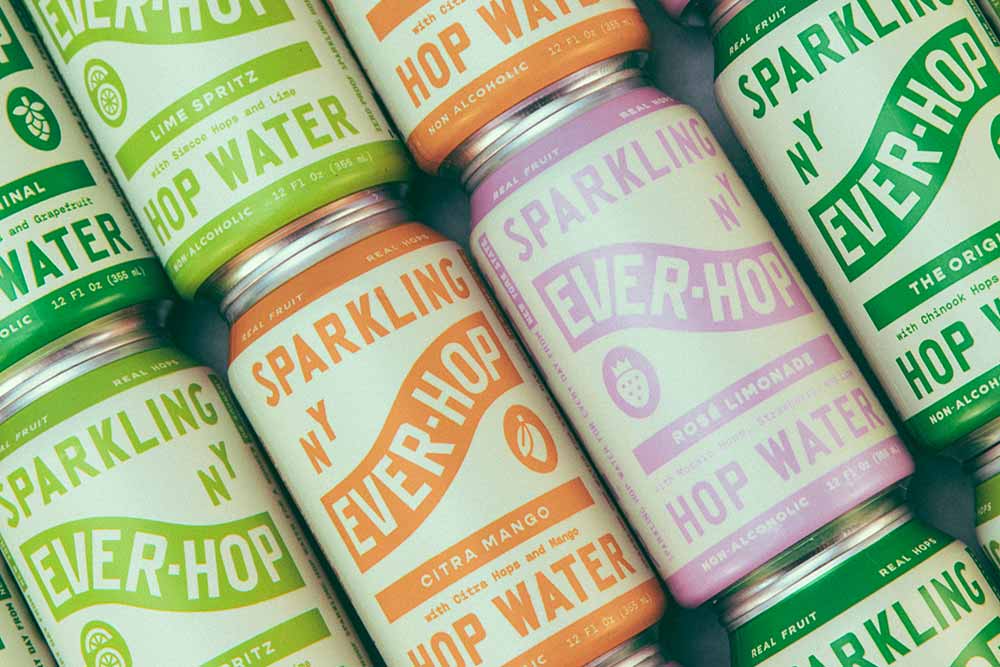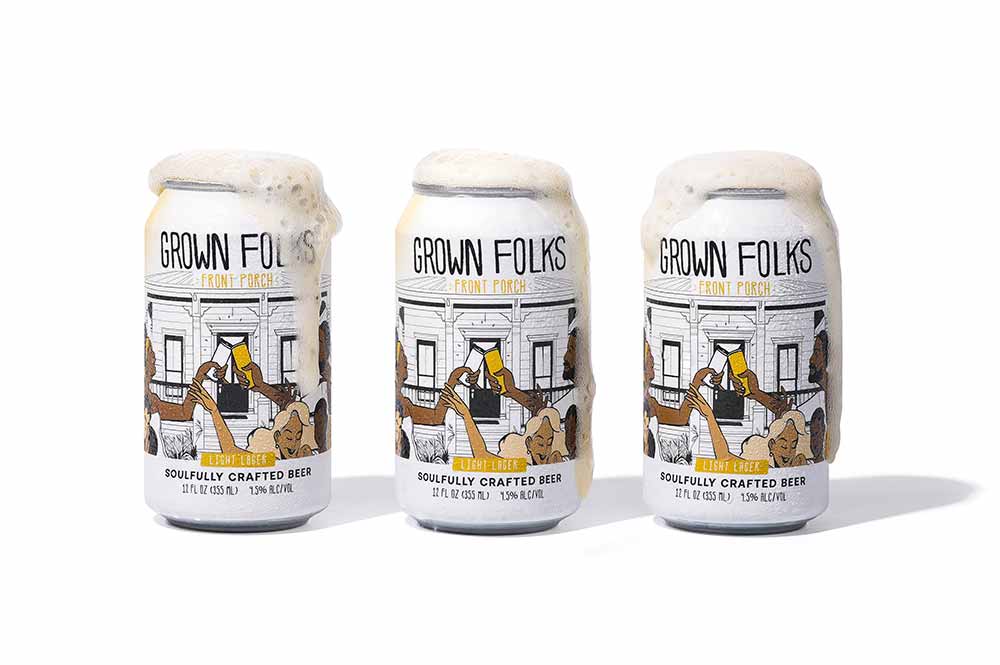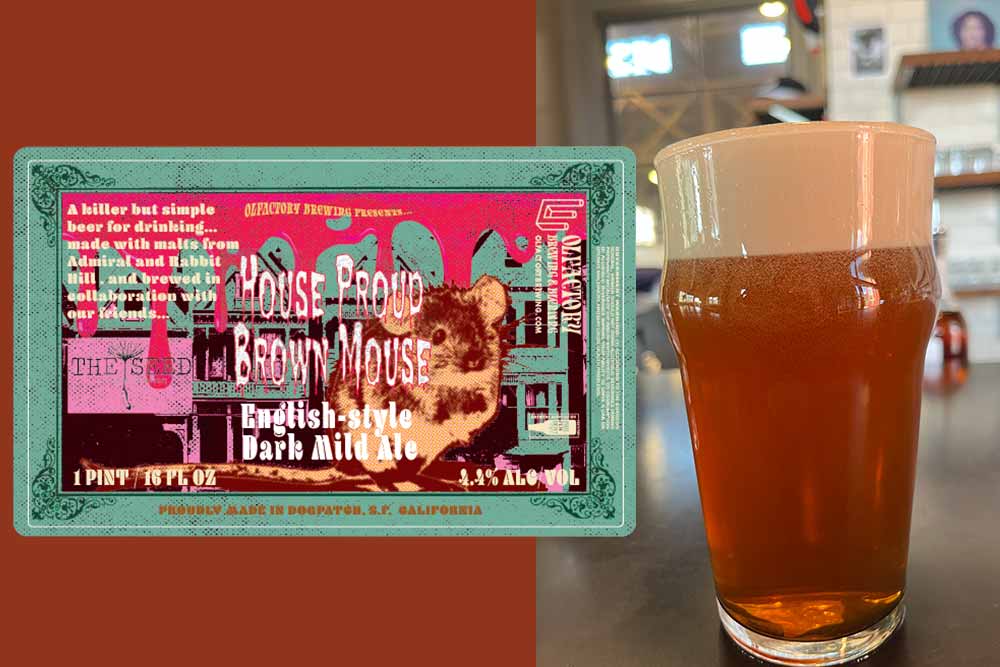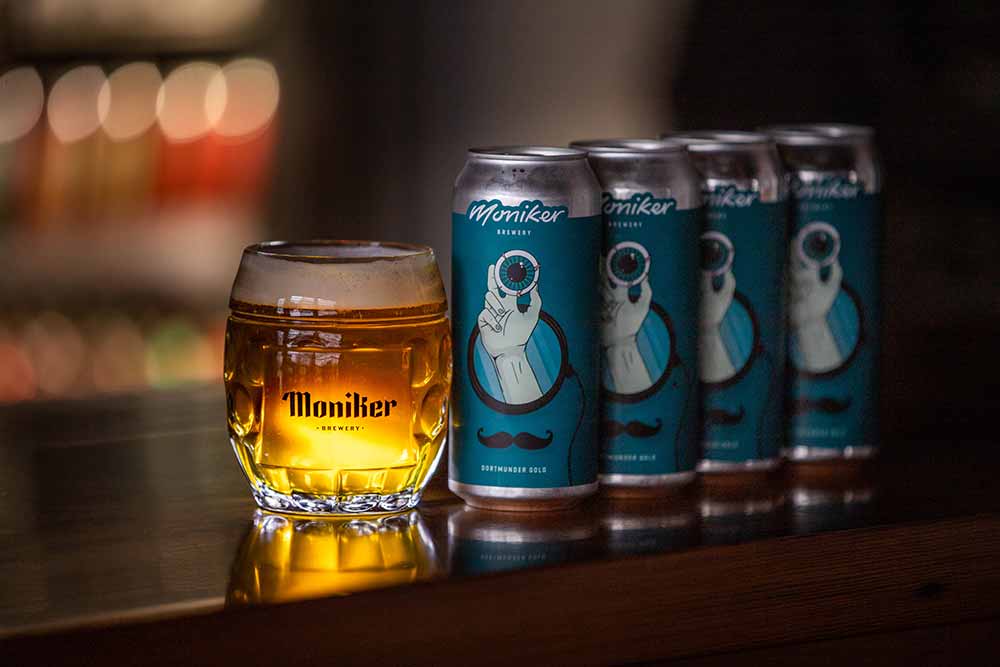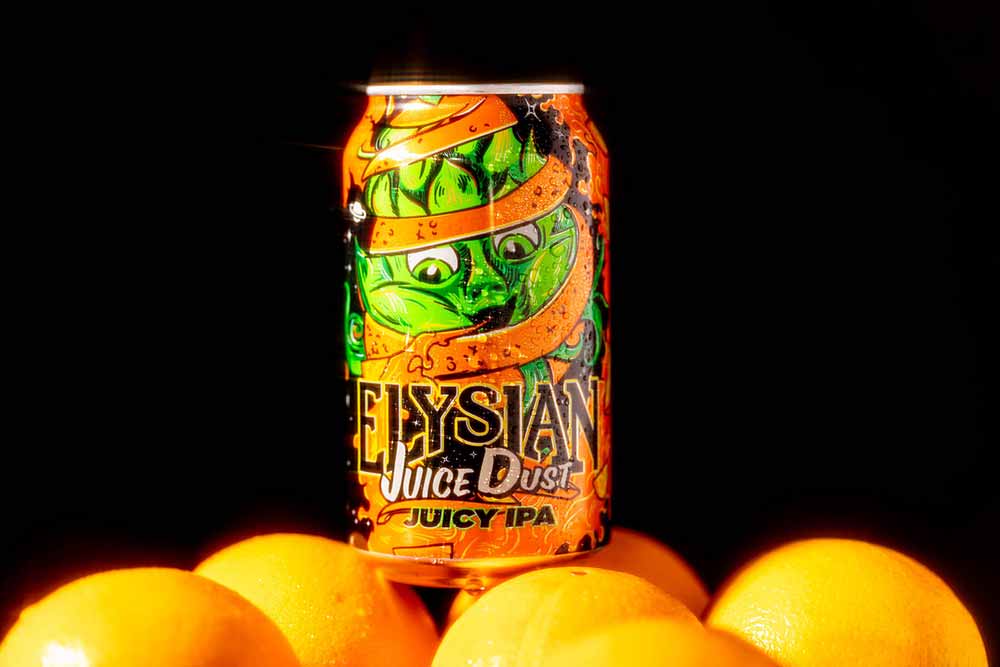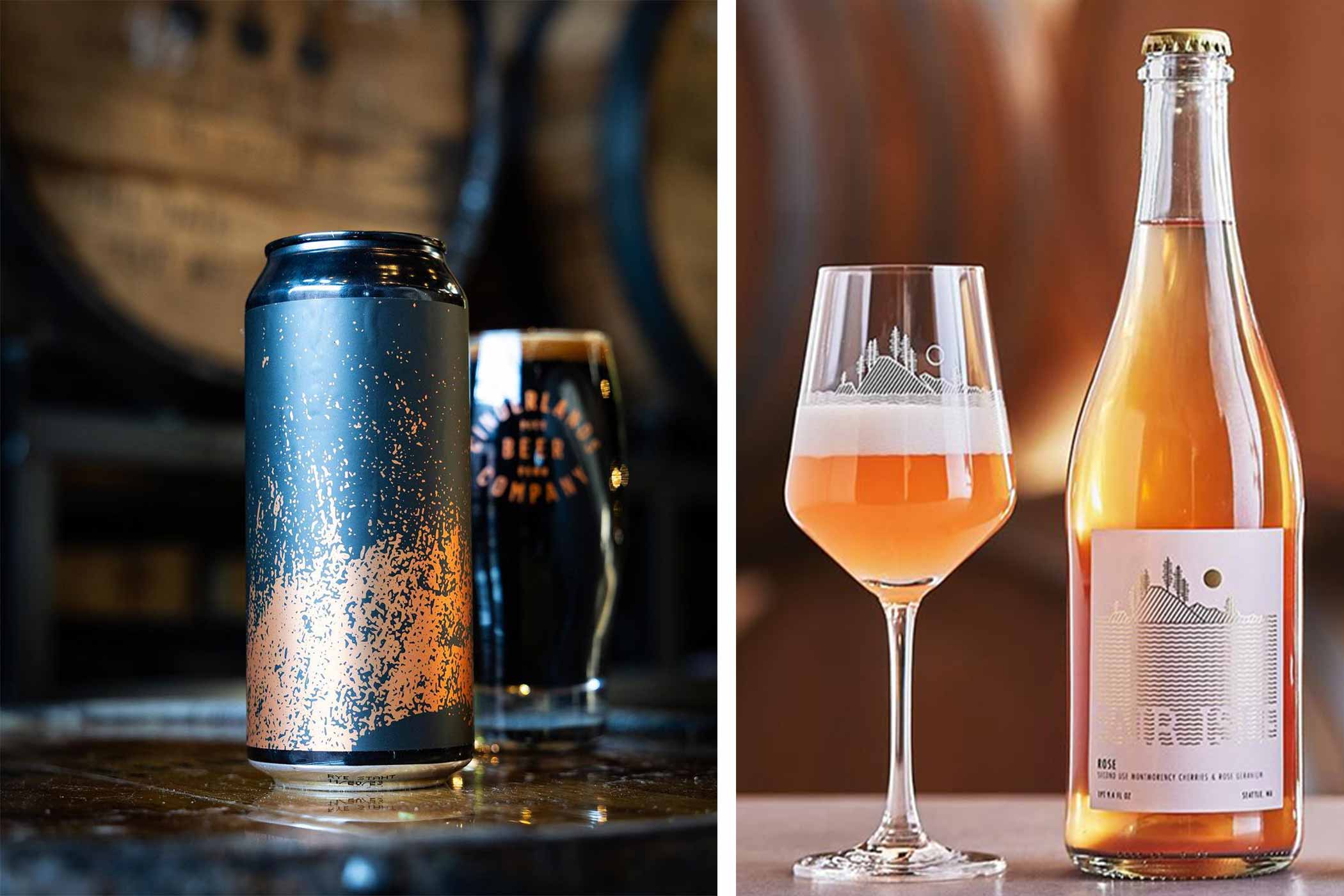Shop
The Top Fifteen Beers We Drank in March 2024
Looking for More Top Lists?
If March showers bring the proverbial April flowers than this month definitely rained beer down on us. We had so much good stuff to drink these thirty-one days, that we’ve put together our biggest version of this monthly series ever!
The team took a trip to three incredible local breweries—Tenma (one of our “Best Breweries of 2023”), Mad Fritz, and Hanabi Lagers. Expect some fun content around all three of those places this month. But we’re leaving a few teasers here.
We also caught up with von Trapp Brewery, started by the very same family featured in The Sound of Music.
And just tried a whole ton of great beer sent our way.
Let’s just put it like this: We’re already eagerly awaiting whatever beers bloom for us in April.
Hop Culture’s Top Fifteen Beers of March
Helles – von Trapp Brewing
Stowe, VT
Helles – Hey, everyone, this month we wrote a story about how the family (yes, the family) from “The Sound of Music” opened their own brewery in Stowe, VT.
Seriously, make time for this one.
The von Trapps built their brewery on one beer in particular: Helles.
“The helles is what my dad really had in mind for the beer he wanted to create,” explains Sam von Trapp, the current director and executive vice president of von Trapp Brewery and grandson of Maria von Trapp, who wrote “The Sound of Music.”
With roots from the Salzberg, Austria, and Bavaria, Germany, region, Sam’s dad, Johannes, wanted to recreate the crisp, clean, time-honored lager you’d often find in that area.
However, in the early 2000s, you rarely found one in the United States.
“I don’t know if any other brewery in the country was even selling a beer they called helles,” says Sam.
Sam applauds his dad for taking what seemed like a bold, brash approach to brewing in the early 2000s. And they made a damn fine one.
Don’t believe us?
How about John Kimmich, the co-founder of The Alchemist, which lies three miles as the crow flies from von Trapp? Sam says Kimmich offered him a trade in the early days: “A case of Heady Topper sixteen-ouncers for a case of our Helles twelve-ouncers,” Sam recalls. “Just because John really wanted to drink that crisp, clean beer!”
Von Trapp’s helles is a contradiction of sorts—laid back yet complicated, which is precisely what makes it a star.
“The beauty of this beer is that it’s so simple, but that’s also the most difficult thing about it,” says von Trapp Quality Manager Jack van Paepeghem. “There’s so many ways you can mess it up.”
Like everything at von Trapp, the Helles starts with fantastic water fed from a spring Johannes discovered on an 1898 USGS survey map, followed by simple, high-quality ingredients: pilsner malt, Noble hops, and “good, healthy” yeast, according to van Paepeghem.
Following a step mash instead of decoction, the Helles includes a ninety-minute boil before fermenting for fourteen days and lagering for another forty to fifty days, depending.
For a final step, von Trapp naturally carbonates with a spunding device.
“Really not a lot that goes in it, but there’s so much that goes behind it,” says van Paepeghem. “Just good water, good Pilsner malt, a few different Noble hops, and it’s a thing of beauty.”
Van Paepeghem adds, “When Helles is at its best, you don’t have to think about it. You can just enjoy it and drink it. Nothing’s off; nothing singing too loud. It’s just balanced, smooth, super drinkable, and always one of our favorite beers to make.”
And one of their favorite to drink.
At only 4.9% ABV and 20 IBUs, Helles is “the perfect example of that crisp, clean lager my dad wanted to have for all those years,” says Sam, who admits it’s his go-to.
And not just because he loves the taste. This beer has a connection to Sam as deep as their on-site spring.
“The fact that I get to sit down with my dad, who is now eighty-five, and [drink a Helles]; I enjoy every moment I spend with him,” says Sam.
That’s why Sam will drop everything when his Pop calls at 4:30 p.m., asking to grab a beer. As he says, “I know if I’m going over to his house for dinner, I don’t have to ask what beer to bring.”
Carlsbad Crush – Burgeon Beer Company
Carlsbad, CA
Pale Ale – We’ve featured this plush pale ale before, but like the Backstreet Boys’ “I Want It That a Way,” a song we always come back to and belt out loud if we hear it on the radio, Carlsbad Crush is a beer we’re always happy to put in the rotation again.
Featuring Mosaic and Mosaic Cryo hops, Carlsbad Crush has oomph, yet it’s gentle and sessionable with zesty and piney flavors that taste like a refreshing spritz. Sipping this beer gives us all the flavors of the citrus family—tangerine, clementine, pomelo, grapefruit. This beer is perfect for a warm spring day; the only thing that could improve it would be sipping it poolside.
Saison Dupont – Brasserie Dupont
Leuze-en-Hainaut, Région Wallonne, Belgium
Saison – Saison Dupont is Belgium’s best-known and most popular saison. And for good reason. It’s a smooth-drinker with an incredibly soft and dry mouthfeel and the complex flavors of Dupont’s legendary yeast. At 6.5% ABV, it’s not too heavy or too light. Saison Dupont is just an incredibly refreshing beer and a near-perfect beverage.
Saison Dupont pours a cloudy copper with an eggshell creamy foam cap that lingers long after you’ve finished pouring. One of the first things you’ll notice is the carbonation—audible fizzing and rapid bubble movement create a ballet in your glass.
You’ll find scents of freshly baked lemon bread, touches of clove and nutmeg, and a bit of peppery spice. The flavor beautifully combines ripened fruit (a little lemon, some berries, and orange peels), earthy bitterness, floral tartness, and black pepper spice.
The entire experience situates you in the rustic countryside. It’s a beer that’s easy to fawn over but will play a supporting role alongside your meal. It doesn’t get much better than this.
All of these are reasons why we named Saison Dupont one of our “27 Most Iconic Beers to Drink in Spring.”
Want to see the rest? ⬇️⬇️⬇️
Want to drink this beer yourself at home? Our friends at Untappd have it available in The Shop. Check it out! ⬇️⬇️⬇️
BUY THIS BEER IN THE UNTAPPD SHOP
Well, Actually – Cloudburst Brewing
Seattle, WA
New Zealand-Style Extra Pils – “We know what you’re thinking,” queries Cloudburst. “What the f**k is a New Zealand-style Extra Pilsner?” In the mind of one of the best breweries in Seattle, this style, although not technically recognized by any of the major awards, emphasizes “extra.”
Essentially a German-style pils, this beer gets a little extra Southern Hemisphere flavor. Hops express an uber-vivid fruitiness that reminds us of pink Starburst, Meyer lemon jam, and green grapes.
“That said, it’s not dry-hopped, nor is it hopped at the rate of a contemporary American pils or nowhere near the rate of a West Coast pils,” Cloudburst explains.
Well, Actually, we detect a very dominant and pleasant maltiness—like the crumbly baked edges of a scone that catch and bake a little more. Slather that scone with some apricot jam, and you get that schmear of fruitiness running through here.
Cloudburst uses an Extra Pale Pilsner malt to lighten up the character and color while also drying the beer to make this, as they say, “a delicious little lager.”
The Smoke – Cellador Ales
Torrance, CA
Lichtenhainer Style Sour Ale – A smoked lower-gravity historical German sour wheat beer, Lichtenhainer is a style we barely see. And who better to lend their expertise to this type of beer than our friends at Cellador Ales, one of the country’s few one hundred percent oak barrel-fermented breweries?
For the aptly named The Smoke, owner Alex Ourieff starts with a smoked sour base courtesy of Beechwood smoked malt before conditioning it with a house-mixed culture and fermenting in freshly dumped red wine barrels. Naturally carbonated with local orange blossom honey, Smoke is truly a beer that lives and changes as you sip.
On the nose, you’ll get this complex parmesan rind, followed by a hint of freshly pressed apple juice. That follows through on the sip before a bubble of pleasant smokiness pops up like a submarine breaking through the water’s surface. It lingers like a good conversation but doesn’t overstay its welcome.
With our brains ping-ponging, we immediately wanted another sip: a hit of apple juice and a burst of smoke mid-body had our eyes popping again. Pretty cool!
Convex Refraction – Jackie O’s Brewery
Athens, OH
Doppelbock – Topping Untappd’s All-Time Top-Rated List of Doppelbocks, Convex Refraction from Jackie O’s starts with caramelized Haus Malts Triticale malt before spending an epic fourteen months in bourbon barrels. Brewed in collaboration with Burial Beer Co., Convex Refraction shows how this relatively humble dark German-style lager can reach new heights through barrel aging.
The Wolf in Sheep’s Clothing – Mad Fritz
St. Helena, CA
Roggenbier – There is only one way to describe Nile Zacherle, brewer, maltster, roaster, and co-founder of Mad Fritz: mad scientist. When you talk to him about his tiny appointment-only brewery in St. Helena, CA, his eyes gleam with a radiant and infectious energy.
When we visited one beautiful weekend in March, despite being on crutches from a sledding accident, Zacherle didn’t miss a step, spoiling us with taste after taste of his small-batch sensations.
Zacherle started homebrewing with his dad in Hawaii when he was only nineteen. You can still see the proof in a black folder stocked with all his old recipes. Stained, lopsidedly xeroxed, and written with hand-scrawled notes, each page takes you to another part of Zacherle’s life. For instance, you’ll find beers like a High Honey Lager and People’s Pilsner from his time brewing all through college.
“We were infusing ganja into the beers!” exclaims Zacherle, who eventually received his BS in Fermentation Science at UC Davis (where he kept yeast slants in his fridge and set up a ten-barrel brewing system in his apartment) and completed the Masters Brewing Program in 1996 before working at Anderson Valley Brewing Company [AVBC]).
“But after about six months, I went into [then-AVBC-Owner] Ken Allen’s office,” says Zacherle. “He had just smoked a joint, and I was hot boxed in there. And I’m like, dude, I got to make, like, $30,000 a year to stay on.”
So the aspiring brewer pivoted, putting all his brewing equipment in storage and traveling the world, from Australia to France, making wine. But Napa Valley called him back, first as the assistant winemaker under Bo Barrett at Chateau Montelena and then as the head winemaker at David Arthur Vineyards, where he’s been for the last seventeen years.
Zacherle could only meet us in the morning the day we visited because he had to take some Mad Fritz beer to Barrett’s seventieth birthday party.
“I’ve got a green pilsner I’m going to be pouring him,” Zacherle shared. “I wouldn’t normally make a green beer, but for Bo, I’ll do it!”
Yes, you’re reading this right. Zacherle is currently still a head winemaker for a significant Napa Valley winery. Mad Fritz? That’s just his side passion project.
One might call Mad Fritz Zacherle’s little crazy laboratory. A place driven by the pursuit of the perfect fruit to use in a kölsch with white fig that’s “the protagonist in the beer without taking over the beer,” says Zacherle.
Or the perfect water source for a single-origin beer focusing on ingredients just from Mendocino County (still in the works as of publication). And hops. “There was no one growing f**king hops in Mendo? Like WTF,” Zacherle shared, who eventually got connected to these two guys growing some after hearing about them through the grapevine at his son Fritzy’s soccer game.
Or a blue corn pale ale with twenty-five percent blue corn milled using old French quartzite stones at the historic Bale Grist Mill, which they malt in the warehouse next door to the tasting room. (Zacherle says they can floor-malt about 500 pounds of malt at a time!)
‘We’re one of the few breweries in the world that has a hop kiln, a malt house; we’re sourcing waters; we’re taking things to a really extreme source origin level,” says Zacherle. “You’re drinking something that’s a reflection of just a lot of freaking work.”
Like a dry-hopped pilsner made with the “softest water in Napa Valley,” according to Zacherle, who eagerly wanted us to do a water tasting of the reservoir water he had collected in his beer van. We got too distracted by the beer. “That’s how geeky I get with beer,” he giggled.
Or an alternative-grain IPA that blew Hop Culture Social Media Manager Magic Muncie’s mind—“I’m pretty sure it’s one of the best gluten-free beers I’ve ever had!” he said.
A golden ale with single-hive honey from Rancho Chimiles Honey that Zacherle zips into the hopback to retain the integrity of the honey as much as possible.
Or a roggenbier, a historical Bavarian beer typically made with a predominant grist of rye malt and hefeweizen yeast.
“There are so many damn beers that I like to say I struggle with a condition known as OCBD: obsessive-compulsive brewing disorder,” jokes Zacherle.
These beers have a soul—a sense of being and place—probably why Zacherle calls them “origin beer.”
Of the probably seven to nine we tried during the two and half hours, we shot the shit with Zacherle, the latter roggenbier, The Wolf in Sheep’s Clothing, just stuck in our minds.
“It’s forty-five percent malted rye with no hull. So when you’re making this beer, it’s a soupy rye,” says Zacherle. “I like to say it’s a banana pumpernickel bread beer.”
Which is exactly what this beer tasted like. Thick, rich, rye, dry. Just delicious.
“When I think about making a new beer for Mad Fritz, it has to be something that’s just kind of a different category; it just touches a different flavor spectrum,” espoused Zacherle. “And this was something that was clearly like that.”
And you can’t just get Mad Fritz beer anywhere. You have to be one of the lucky 500 members. Not a part of the club? Don’t worry; Zacherle says he opens subscriptions every quarter.
“And that allows us to do whatever we want to do. That allows us not to make hazy juicies. We don’t can, we don’t do off-premise,” he said. “We can do whatever we want. We don’t make pastry stouts. We do whatever we want or subscribe to one style of beer. And that’s the beauty of it.”
Mad Fritz is a brewery that, as Muncie said during our visit, is a “goosebump-type of situation.”
Hanabi Lager Haná Pilsner Style Lager – Hanabi Lager Company
Napa, CA
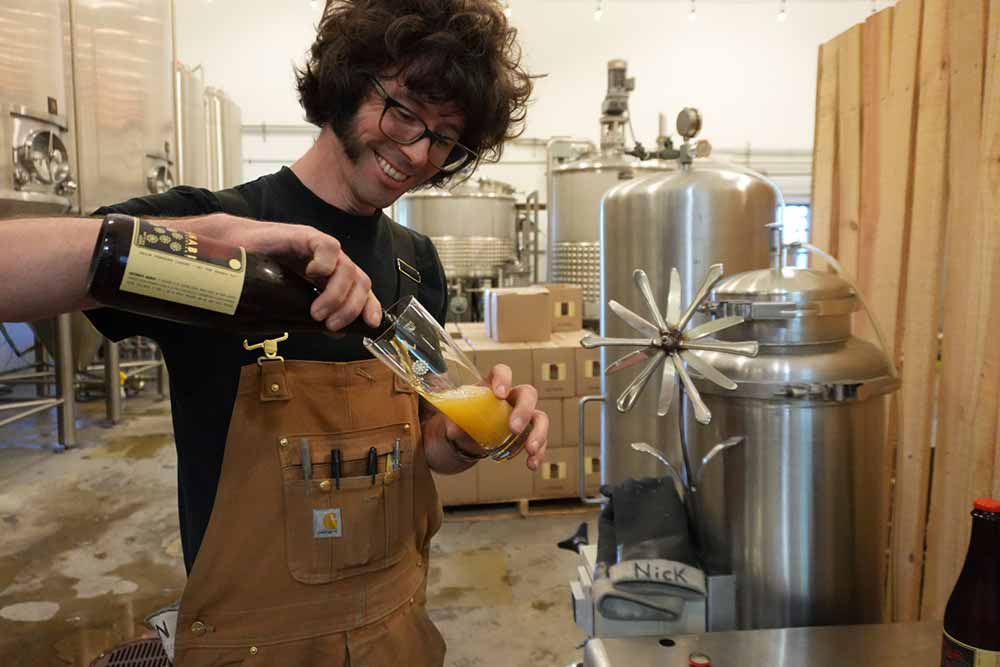
Photography courtesy of Grace Lee-Weitz | Hop Culture
Pilsner – Haná grain. We’re putting those two words first because, to Nick Gislason and Hanabi Lager, grain is the most important ingredient in beer—not just the ingredient itself but the hands behind it, the history of its germination, and the story of its survival.
At the tiny hand-built brewery in a bay of an old sake plant, Hanabi Lagers uses one of the world’s most popular beer styles to showcase the flavors, complexities, and textures of grain.
I guarantee you that if you ever have a chance to enjoy Hanabi’s only flagship beer—Haná Pilsner—it won’t taste like any lager you’ve had before.
As we sipped the pale gold liquid in tall, clear glasses, Nick told us a few stories.
The boyishly handsome Gislason, whose shaggy hair, mutton chops, and tan overalls make him unmissable, told us that he grew up in the San Juan Islands of Washington, where “If you’re on the edge of the island looking out across the channel, you’ll see a couple of orcas and then Canada,” he says.
His family’s land started with nothing before his parents, along with him and his brother, built everything on it. What Nick calls a “modern-day homestead.”
During the summertime, haying season, kids in the area would buck bales for meager bucks. Nick learned to build fireworks in his free time, apprenticing with Dwight Walters, a master firework builder on Lopez Island. Twelve-year-old Nick would catch the red-eye ferry, working from 6 a.m. until right before the last boat back at night. While waiting, he hung out in Walters’ home. A geologist and oenophile, Walters had an extensive collection of two things: books and wine.
“He would pour me just a little taste and tell me, oh, it’s this winemaker and this type of soil and all this,” says Nick. “So that lit the spark pretty early for me.”
At the same time, Nick started homebrewing, a hobby he picked up at the tender age of twelve from his uncle.
“I definitely took to it, and I thought it smelled good,” shares Nick, who designed all his homebrew equipment himself.
He welded together empty kegs he bought for $15 or $20 bucks from the local pub—Herbs Tavern—in Mr. Fab’s welding shop, where he worked for trade: sweeping the floors in exchange for using the equipment.
Nick’s parents only allowed him to brew, not actually drink any alcohol himself.
At community gatherings, frequent in the San Juan Islands, a refrain became popular: “Oh, it’s the Gislason kid bringing the beer again!” laughs Nick
After college, Nick bopped around working at Boundary Bay Brewing Company. “I loved it; it was just a total blast,” he says. “I loved the hustle.”
But he missed the outdoors, where he spent most of his time growing up.
He wanted to connect with his ingredients, to touch the field where the grain came from, to smell the stalks, and to pick it before he brewed it.
What follows next can only be described as incredible, but the more you talk with Nick and get to know him, the more it just makes sense.
Winemaking in the hills of Napa…winemaking in New Zealand…UC Davis Masters Degree in Winemaking and Viticulture…passing the Master Brewer’s exam…becoming the head winemaker at Screaming Eagle.
Along the way, Chuckanut taught Nick and his wife Jen, also a winemaker, to appreciate lagers.
On the side, they kept brewing for viticulturists, winemakers, and community events.
Two barrels became five, became seven until both knew they had to start a business with one focus.
“Let’s just take people on this journey with us to explore grain, which is, besides water, the main ingredient in beer,” says Nick. “We felt like it just deserved the spotlight. It seemed so obvious.”
Nick and Jen initially thought they’d brew only four times yearly, rotating a different grain each season—fall, winter, spring, and summer.
Which they do to this day, but with their initial beer, Haná Pilsner Style Lager, they fell in love.
They fell in love with Haná, a grain named after the Haná Valley in the Czech Republic, where it was used to brew the world’s first pilsner (remind us to tell you that story sometime, too).
Today, the grain is basically extinct. Only a handful of breweries have access to Haná (literally, Nick said he could maybe name five, including Hanabi).
Hanabi only does this because of Nick’s connection with Ian Ward, then-president of BSG in 2014. A wine lover himself, Ward hit it off with Nick, sharing with him a new program BSG started to highlight old, heirloom grain.
Hanabi was among the first breweries in the States to brew with Haná. And, like we said, fell in love.
“This would be our desert grain,” says Nick as we cheers and take a sip “It has texture and a mid-palate complexity, but freshness at the same time. It was like Chardonnay to the grain world.”
He’s right. The 4.6% lager has a lightness and freshness playing in the sandbox with a chewiness and texture.
Now Nick brews Haná Pilsner over and over, tweaking and tinkering each time.
“We’ll never be done honing,” he shares excitedly. “That’s just the way we are.”
Great! Because we’ll keep drinking ‘em.
Slow Decay – Tenma Beer Project
Oakland, CA
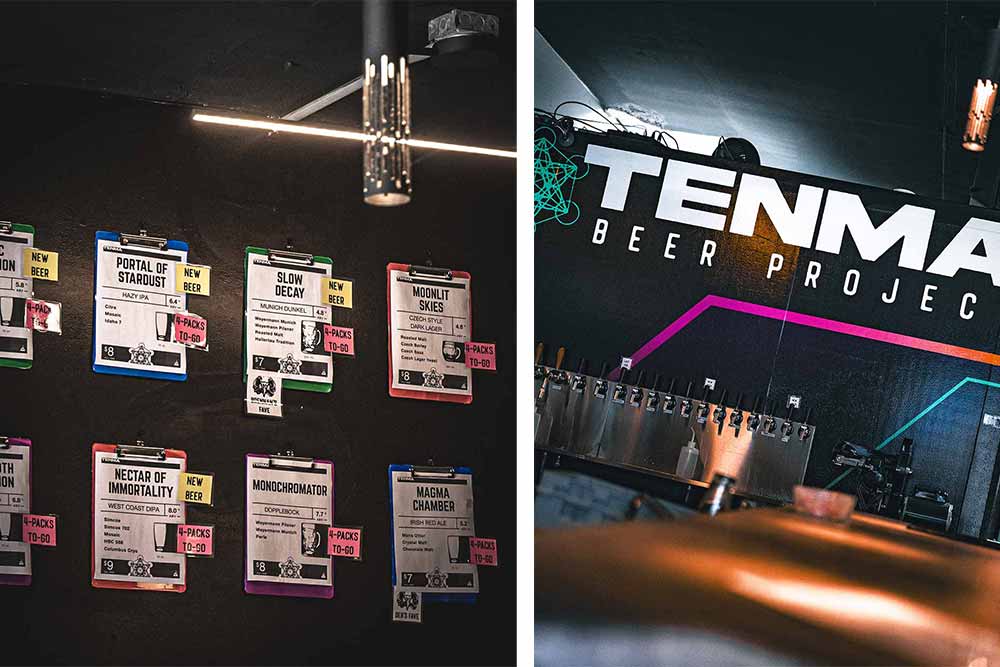
Photography courtesy of Magic Muncie | Hop Culture
Munich Dunkel – We finally had the chance as a team to visit one of our “Best New Breweries of 2023.”
At Tenma, the two most important words are “Beer Project.” Well, also lean and agile, but we’ll get to that later. Industry veterans familiar with working twelve-hour shifts and eighty-hour work weeks, Dana Martindale and Brennan Perry finally decided they wanted to go into business for themselves.
Essentially, they run Tenma Beer Project by themselves (plus a couple of part-timers in the front of the house).
Call them gluttons for punishment, but the blood, sweat, and beers have paid off.
On Tenma’s 7-bbl brew system, in just ten months, Perry has already picked up a GABF bronze medal for a German-style pilsner called Don’t Fear the Answer (it’s killer; we were lucky enough to enjoy batch number two when we visited) and a Bistro IPA gold and People’s Choice Award for Infinite Self: Nelson.
Which shows you the breadth at Tenma—a point of pride for the duo.
Martindale likes to tell folks who come to drink that the beers available will constantly evolve and change. “I don’t even promise to make the same beer again, or if we do make the same beer, it’s going to be slightly different each time,” she says. “Rather than core brands, we have what I call core styles. … I can promise you, we’ll always have a pilsner on tap, a West Coast IPA on tap, a pale ale on tap, regrettably a hazy on tap, a dark lager.”
Hence: beer project, a living, breathing, experimenting, growing thing.
Walk in on a Friday afternoon and peer up at the twelve multi-colored neon clipboards behind Tenma Beer Project’s bar, and you’ll truly find a little bit of everything.
Underneath some of the beer flyers, you’ll see little laminated stickers proclaiming “Dana’s Fave,” their Czech dark lager, Moonlit Skies (so yummy; and pro tip, ask for a Mlíko of this one, you’ll get a small glass full of frappuccino-like foam), or “Deb’s Fave,” for Deb Tenma, the third co-owner in Tenma Beer Project and Perry’s mom, and “Brennan’s Fave,” currently attached to Slow Decay.
After our visit, we have to say Slow Decay is one of our favorites, too.
The first beer Perry ever brewed at Tenma, Slow Decay is a house dark lager, a Munich dunkel inspired by the first style of lager Perry homebrewed. He kept that idea in his head all through stints at Stone and Beechwood until he had that chance while working at TAPS to brew one that won bronze at GABF.
He took that idea, rewrote the recipe, and made his own Munich dunkel at Tenma.
“It’s basically just Munich [malt], a touch of German crystal malt for aroma, a little bit of Pilsner [malt], and all Hallertau Tradition,” says Perry. “I try to keep beers really simple. Especially for German lager, you don’t need to get too fancy.”
This beer exudes simple perfection. And for us, it encapsulates Martindale, Perry, and Tenma’s DNA.
Schwarzbier – Westfax Brewing Company
Lakewood, CO
Schwarzbier – The aptly and simply named Schwarzbier from Westfax gives us everything we wsnt from this German black lager: unwrapping a Lindt milk chocolate truffle, dipping a piece of crumbly scone in chocolate fondue, or dunking a snickerdoodle cookie in chocolate milk. And yet, while these descriptors seem pretty unctuous, Schwarzbier finishes imminently crisp and clean with a pleasant lightness. It’s like eating a s’more without the marshmallow—all chocolate and graham crackers.
Ever Hop Lime Spritz – The Drowned Lands Brewery
Warwick, NY
Hop Water – The Drowned Lands makes some of our most treasured and favorite beers. So when Founder Mike Kraai reached out to us about a new line of hop waters they’re producing called EverHop, we knew we had to try them.
“Born in the Hudson Valley, EverHop is the only hop water crafted with real hops and real fruit additions that complement and enhance the hoppy goodness,” Kraai shared with Hop Culture Senior Content Editor Grace Weitz in an email. “It contains no gluten, alcohol, extracts, artificial sweeteners, or added sugars. Or, as we like to say, ’All of the Bubbles, None of the Troubles!’”
Weitz tasted all four flavors—the Original, Citra Mango, Rosé Limonade, and Lime Spritz. Overall, these hop waters are seriously legit. They are almost on another plane, each with its own spritzy carbonation and an outstanding balance of hop flavor.
An avid sparkling water drinker (two a day minimum), Weitz has pretty high standards in the land of bubbles. Cold, crisp, and carbed are the three pillars she feels bubbly beverages need to hit.
EverHop delivers on all three. And then some with a sparkle of real fruit and, of course, hops.
In each flavor, the hops and fruit sing together.
Weitz enjoyed all the varieties but fell in love with the Lime Spritz, which has an extra citrus zest zip that adds another layer of complexity. The 12oz can packs incredible carbonation and tang, complemented by a rich limeness that still feels light. “Zesty” and “zippy” are written right on the can and are the best way to describe this spritz. Simcoe hops combine with refreshing lime juice to give that pleasant pop of pineyness, apricot, and peach.
Kraai said he leans toward the Rosé Limonade, mentioning that everyone seems to have a different favorite. According to Kraai, “EverHop uses a really unique and innovative hop technique to maintain vibrant tropical flavors without any vegetal matter.”
While he didn’t say more, consider us converted. And if you need more proof, Weitz said she sat down to just “test” each 12oz can…and, throughout writing this piece, drank all four dry to the bone.
Front Porch Lager – Grown Folks
Los Angeles, CA
American Light Lager – The first female- and black-owned beverage brand in Los Angeles, Grown Folks make what they call “soul food-inspired hard seltzer and premium craft beverages.” Founded by entrepreneur Danica Dias, Grown Folks takes inspiration from Dias’ time spent growing up in a big Lousiana Creole family where adults were always known as “Grown Folks.”
The idea to craft beverages based on beloved soul food dishes came to Dias while cooking her late Grandma’s handwritten Peach Cobbler recipe during the pandemic lockdown.
Grown Folks was kind enough to send us a package, sharing their three hard seltzer flavors, Peach Cobbler, Ambrosia, and Key Lime, along with their Front Porch American light lager.
We’re suckers for a good crisp, classic foundational lager, and this soul-inspired one certainly fits the bill. Predominant maltiness upfront quickly dissipates into an almost lemon/lime Sprite character that gets you ready for the next sip.
Crack one, sit on the front porch, and while away the night.
House Proud Brown Mouse – Olfactory Brewing
San Francisco, CA
ESB – Hop Culture Senior Content Editor Grace Weitz had a chance to attend the opening reception of MaltCon, hosted this year at Admiral Maltings taproom called The Rake. About twelve beers on the tap list featured malt from a craft maltster such as Admiral Maltings, Blue Ox Malthouse, Riverbend Malt House, Root Shoot Malting, and more.
Weitz especially enjoyed House Proud Brown Mouse, an English-style dark mild collab between Olfactory Brewing and The Seed. Fermented with the famous Landlord yeast, House Proud Brown Mouse also inlcudes eighty percent Rabbit Hill Malt Chillum malt and the rest split between Admiral’s Hearth and Kilnsmith. Served on cask, this beer brilliantly showcased how a simple beer can just kill it.
Graham cracker, cocoa, and milk chocolate all harmoniously blended without one flavor outshining the other. This beer felt like a true malt expression. Weitz thought she could have crushed three or four of those. But with so many other great beers to try that night, she forced herself to stick to just one. Editor’s Note: In fact, she enjoyed this beer so much that she forgot to take a picture of it!
This beer showed Hop Culture how craft maltsters are quickly becoming the unsung heroes of craft beer, so look out for a larger story from us in the future!
Monikel On – Moniker Brewery
Providence, RI
Dortmunder – Moniker Brewery calls this collab with Shaidzon Beer Co. a Goldilocks beer. And we have to say we agree! Monikel On immediately sprouts a malty breadiness on the nose undercut by just a slight ripple of spiciness (probably thanks to the one hundred percent Proximity Malt). Totally delicious, like fresh baked Irish soda bread or English crumpets, this Dortmunder drinks like a “bigger, maltier pilsner,” according to Moniker.
Again, we couldn’t agree more. “A crisp and clean taste with a balanced malt sweetness, subtle hop bitterness, and hints of biscuit-like flavors, creating a refreshing and satisfying drinking experience.” This is a simple, humble style, but we can’t help but feel like, with this beer, Moniker has treated us to high-noon tea and crumpets.
Juice Dust Juicy IPA – Elysian Brewing Company
Seattle, WA
Hazy – Building of its uber popular core beer (and character) Space Dust, Elysian Brewing in Seattle, WA, released Juice Dust last month. “People want to try what’s next in the story,” said Elysian Brewing Sales Director Auggie Katzer during a virtual tasting. “As we ride out that juicy wave, we’re very excited for the opportunity at hand.”
Although sitting at the same 8.2% ABV as Space Dust, Juice Dust amps up the IBUs slightly, but really blasts off in juiciness. In fact, Elysian Brewing Brewmaster Chris Murakami says inspiration came to him during a brainstorming session when someone wrote, “Tang” on the whiteboard.
Murakami says he experimented first by adding Tang to Space Dust. “The aroma was awesome!” he said. Although no Tang made it into the final recipe, orange juice did. Juicy Dust gets a splash of orange alongside of malt bill packed with oats (almost twenty percent of the grist, according to Murakami), for a beer that’s a part of your complete breakfast!
We noticed big notes of citrus and tropical fruit.
Murakami says that right away you should be getting “a lot of orange, orange zest and sometimes tropical fruit like mango or papaya.”
A thicker mouthfeel and body from the oats also gives the beer a lovely plush softness. And while this beer hits 8.2% ABV, if you drank it blindfolded, you’d never tell.
Juice Dust should be a fine companion alongside Space Dust on shelves.

